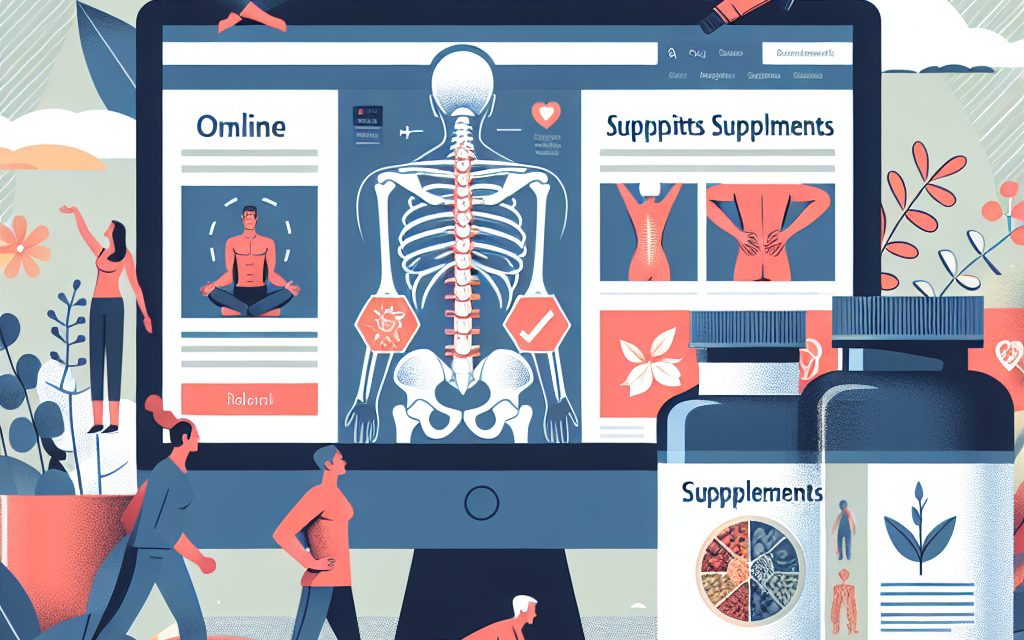Innovative Online Solutions and Supplements for Chronic Back Pain Relief
Chronic back pain is a prevalent issue affecting millions of people worldwide. It can stem from various causes, including injury, poor posture, and underlying medical conditions. As traditional treatments often fall short, many individuals are turning to innovative online solutions and supplements for relief. This article explores five key subtopics related to these modern approaches, providing insights into their effectiveness, accessibility, and potential benefits.
1. Understanding Chronic Back Pain
Chronic back pain is defined as pain that persists for 12 weeks or longer, even after the initial injury or underlying cause has been treated. It can be debilitating, affecting daily activities and overall quality of life. Understanding the nature of chronic back pain is crucial for exploring effective solutions.
There are several types of chronic back pain, including:
- Mechanical Pain: This type is often related to the spine’s structure and can be caused by muscle strain, ligament sprains, or degenerative disc disease.
- Nerve Pain: Conditions like sciatica occur when nerves are compressed or irritated, leading to pain that radiates down the leg.
- Referred Pain: Sometimes, pain in the back can be a symptom of issues in other parts of the body, such as the kidneys or pancreas.
Statistics indicate that approximately 80% of adults will experience back pain at some point in their lives. The economic burden is significant, with costs related to treatment, lost productivity, and disability claims reaching billions annually. Understanding these factors is essential for developing effective online solutions and supplements.
2. The Rise of Telehealth for Back Pain Management
Telehealth has revolutionized the way patients access healthcare, particularly for chronic conditions like back pain. This approach allows individuals to consult with healthcare professionals from the comfort of their homes, making it easier to receive timely care.
Key benefits of telehealth for back pain management include:
- Accessibility: Patients in remote areas or those with mobility issues can access specialists without the need for travel.
- Convenience: Scheduling appointments is often more flexible, allowing patients to fit consultations into their busy lives.
- Cost-Effectiveness: Telehealth can reduce costs associated with in-person visits, such as transportation and time off work.
Several studies have shown that telehealth can be as effective as traditional in-person visits for managing chronic back pain. For instance, a study published in the journal JAMA Network Open found that patients receiving telehealth interventions reported similar levels of pain relief and satisfaction compared to those who attended in-person sessions.
Moreover, telehealth platforms often provide access to a range of services, including physical therapy, pain management consultations, and psychological support. This holistic approach can address the multifaceted nature of chronic back pain, leading to better outcomes for patients.
3. Online Physical Therapy Programs
Physical therapy is a cornerstone of back pain management, and online programs have emerged as a viable alternative to traditional in-person sessions. These programs often include guided exercises, educational resources, and personalized treatment plans tailored to individual needs.
Benefits of online physical therapy programs include:
- Personalization: Many programs use assessments to create customized exercise regimens that target specific issues.
- Flexibility: Patients can complete exercises at their own pace and schedule, making it easier to integrate therapy into their daily routines.
- Cost Savings: Online programs are often more affordable than traditional physical therapy sessions.
For example, platforms like PhysioRoom and Hinge Health offer comprehensive online physical therapy solutions. These programs often include video demonstrations, progress tracking, and virtual check-ins with licensed therapists. A study published in the journal Physical Therapy found that patients who engaged in online physical therapy reported significant improvements in pain levels and functional mobility.
Additionally, online physical therapy can be particularly beneficial for individuals with busy schedules or those living in areas with limited access to healthcare services. By leveraging technology, patients can receive high-quality care without the barriers associated with traditional therapy.
4. Supplements and Nutraceuticals for Back Pain Relief
In addition to online therapies, many individuals are exploring dietary supplements and nutraceuticals as adjuncts to their pain management strategies. These products can help reduce inflammation, support joint health, and alleviate pain.
Some popular supplements for chronic back pain relief include:
- Turmeric: Curcumin, the active compound in turmeric, has anti-inflammatory properties that may help reduce pain and improve function.
- Omega-3 Fatty Acids: Found in fish oil, these fatty acids can help decrease inflammation and may provide pain relief for some individuals.
- Glucosamine and Chondroitin: These supplements are often used to support joint health and may help alleviate pain associated with osteoarthritis.
Research supports the efficacy of some of these supplements. For instance, a meta-analysis published in the journal BMJ Open found that curcumin supplementation significantly reduced pain and improved function in patients with osteoarthritis. Similarly, a study in the American Journal of Clinical Nutrition indicated that omega-3 fatty acids could reduce the need for pain medications in individuals with chronic pain conditions.
However, it is essential for individuals to consult with healthcare professionals before starting any supplement regimen, as interactions with medications and underlying health conditions can occur. Additionally, the quality and concentration of supplements can vary widely, making it crucial to choose reputable brands.
5. Mindfulness and Digital Therapeutics for Pain Management
Mental health plays a significant role in chronic pain management, and innovative digital therapeutics are emerging to address this aspect. Mindfulness-based interventions, cognitive-behavioral therapy (CBT), and other psychological approaches can help individuals manage their pain more effectively.
Digital platforms offering mindfulness and CBT include:
- Headspace: This app provides guided meditations and mindfulness exercises that can help reduce stress and improve pain perception.
- Woebot: An AI-driven chatbot that offers CBT techniques to help users manage their mental health and cope with chronic pain.
- MyStrength: This platform offers personalized mental health resources, including mindfulness exercises and mood tracking.
Research indicates that mindfulness and CBT can significantly reduce pain levels and improve overall well-being. A study published in the journal Pain found that participants who engaged in mindfulness meditation reported lower pain intensity and improved emotional regulation compared to those who did not participate in mindfulness practices.
Moreover, these digital therapeutics can be easily integrated into daily routines, making them accessible for individuals seeking relief from chronic back pain. By addressing the psychological components of pain, these solutions can enhance the effectiveness of physical therapies and supplements.
Conclusion
Chronic back pain is a complex condition that requires a multifaceted approach for effective management. Innovative online solutions and supplements offer promising avenues for relief, from telehealth consultations and online physical therapy programs to dietary supplements and digital therapeutics.
Key takeaways from this exploration include:
- Understanding the nature of chronic back pain is essential for effective treatment.
- Telehealth provides accessible and convenient care for individuals managing chronic pain.
- Online physical therapy programs offer personalized and flexible treatment options.
- Supplements like turmeric and omega-3 fatty acids can support pain relief but should be used under professional guidance.
- Mindfulness and digital therapeutics can enhance pain management by addressing psychological factors.
As technology continues to evolve, the landscape of chronic pain management will likely expand, offering even more innovative solutions for those seeking relief. By combining these modern approaches with traditional methods, individuals can take proactive steps toward managing their chronic back pain and improving their quality of life.





